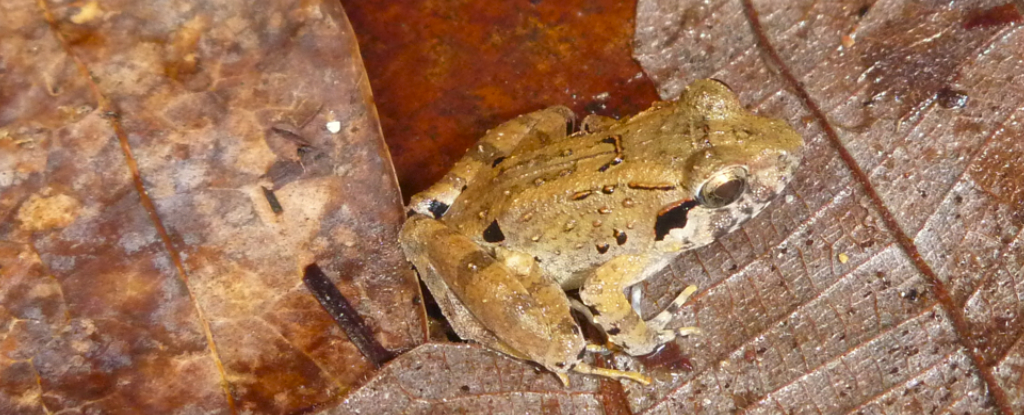The lush, volcanic hills of Sulawesi in Indonesia are home to several species of fanged frogs with unusual reproductive habits, including Limnonectes larvaepartus – the only species of frog in the world known to give birth to live tadpoles.
Now, this tropical island has revealed another one of its secrets: the world’s smallest frog with fangs.
Related to the other fanged frog species, the newly found Limnonectes phyllofolia is a traditional amphibian egg layer.
A team of herpetologists from the United States and Indonesia were hiking through the rainforest when they came across leaves and mossy boulders several feet off the ground that were harboring glassy, black frog eggs.
This immediately caught the researchers’ attention because frog eggs are almost always laid in water to stop their jelly coating from drying out.
Soon after, the researchers caught sight of coin-sized, mottled-brown frogs protecting their nests.
“Normally when we’re looking for frogs, we’re scanning the margins of stream banks or wading through streams to spot them directly in the water,” says lead author Jeff Frederick, a wildlife ecologist at the Field Museum in Chicago.
“After repeatedly monitoring the nests though, the team started to find attending frogs sitting on leaves hugging their little nests.”
These guard-frogs coat their eggs coated with compounds that keep them moist and free of bacteria and fungi.
Curiously, all of the frogs minding the eggs were male. “Male egg-guarding behavior isn’t totally unknown across all frogs, but it’s rather uncommon,” says Frederick.
This never-before-seen species of frog had a ribbon of tiny teeth on its upper jaw and two small fangs protruding from its lower jaw. (Frogs usually only have teeth on their upper jaw.)
“This new species is tiny compared to other fanged frogs on the island where it was found,” says Frederick.
Other saber-toothed frogs on Sulawesi are two-pound giants, but this new species only weighs around two grams – “about the same as a dime,” says Frederick.
The novel species was given the name Limnonectes phyllofolia. (Phyllofolia means ‘leaf-nester’.)
Several species of frogs across Southeast Asia have evolved fangs to battle for territory, mates, and to hunt crunchy prey such as centipedes and crabs.

As leaf-nesting frogs don’t use the waterways to reproduce, they don’t require such large fangs to compete for the best egg-laying spots in a crowded stream.
This could explain their small fang size compared with other frogs on the island, the researchers hypothesized.
Researchers previously found frog fangs have evolved independently at least four times across all frog species.
Studying these species’ behavior and diet revealed frog fangs that evolved in response to sexual selection seem to be relatively larger compared to those evolving in response to other environmental pressures.
Frogs with fangs have been found in Cambodia, Vietnam, west Africa, and South America. Scientists have also discovered fanged tadpoles of the vampire flying frog (Rhacophorus vampyrus) in the evergreen forests of southern Vietnam.
This paper was published in PLOS ONE.





